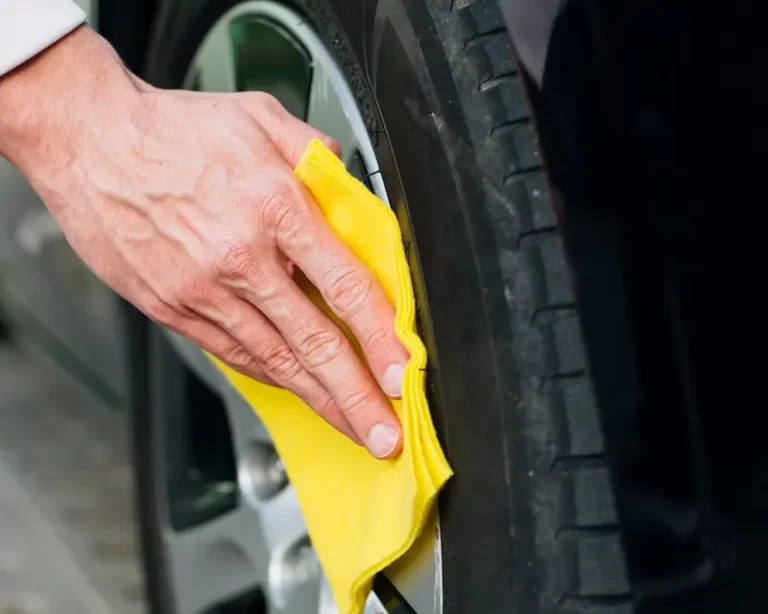It doesn’t matter how carefully you drive or good the driving road is. Sadly, your car rim will get damaged one day. When this happens, how do you fix the cracked rim?
The conventional answer is, “I’ll take the rim to my technician and have it TIG or MIG welded.”
But there’s a better and more efficient way to fix a cracked rim without welding it.
My job in this article is to explain how you can use an epoxy technique to seal a crack on a car rim. Let me walk you down to the destination.
How to Fix a Cracked Rim without Welding
The rim is a critical component of the vehicle. It protects the tire and ensures a smooth, safe ride. Whether it is alloy, steel, spinner, or chrome, a rim can crack at any time. This is usually due to poor driving habits and conditions. These include hitting aggressive curbs, running over potholes, and driving on flat tires or uneven roads.
When a rim cracks, it’ll not hold air, thus causing air leaks. If left unchecked as and when it should, the fractured rim won’t seal the tire bead. As a result, it compromises the structural integrity of the wheel system.
Step-by-Step Guide to Fix cracked Rim
Supplies needed:
- JB epoxy
- Clean rag
- Wire brush
- Fine-frit sandpaper (180-grit)
- Resin tube
- A tire iron
- Hardener tube
- Wheel clocks
- Torque wrench
- Jack stands
Step 1: Park and inspect the car wheel
Pull over your vehicle on a smooth, safe surface. Inspect the wheel with your bare eyes first off. Alternatively, disassemble the entire wheel system to pull out the rim for a proper inspection. Where your bare eyes cannot locate, a wire brush comes in handy. Brush and clean up some reasonable inches on the rim so you can properly locate the broken section.
Step 2: Apply rubbing alcohol
Once you have located the cracked section of the rim, brushed and cleaned it, it’s time to apply some rubbing alcohol on a clean rag. With the rag, wipe down the entire section and extra surrounding inches. Allow the substance to dry on the affected surface.
Step 3: Prepare and Apply the JB Epoxy mixture
Mix a measured quantity of resin with a hardener. Start by turning over the empty box and then stream the hardener into the resin-filled box. Stir the mixture vigorously with a stirrer to ensure all the substances mix well and you get an even color for the epoxy.
Apply the resulting epoxy on the cracked surface of the rim. Smear the mixture using a flat scraper slipped under the epoxy mixture. Then apply it over the fissured part of the rim. Lower down the spatula over the rim to allow the crack to absorb the epoxy. Ensure the mixture gets to about 1”-2” surrounding areas of the crack.
Step 4: Allow the surface to dry
Allow the treated surface to dry for some hours. You can leave treatment overnight to allow the epoxy to bond with the rim. Don’t use a hand dryer or any unnatural drying technique. Allow nature to do the drying and harden the treated surface.
Step 5: Replace the rim
After drying for about 24 hours, check the treated crack to see if the mixture has bonded well with the crack. If yes, it’s now time to reinstall the rim to your car wheel. Make sure you follow the replacement process.
Step 6: Inspect the crack
Now that you’ve completed the process of repairing the crack on your vehicle rim, you’ll need to inspect the job. See for yourself if the result is worth the time and resources expended. If you follow this simple procedure well, you can rest assured that your rim will get back to its old self. You can drive your vehicle around for a few distances.
FAQs
Can I drive on a cracked rim?
I can tell you that it isn’t a safe idea to drive on a damaged rim. The cracks may start to spread, causing the edges of the wheel to expand. If it lingers, the cracked rim may eventually tear apart.
Yes, the crack may neither unfurl nor expand. Yet, you cannot be sure what safety guarantee it gives as your car ages or temperature shifts.
Should I repair or replace a cracked Rim?
If the rim has a small hairline crack located at the rear or middle end of the rim, you can easily fix it. However, a large crack on the front of a rim that spreads in different directions compromises your safety and the structural integrity of the wheel.
Hence, it should be replaced. Again, fixing a steel wheel is safer, more economical, and less danger-prone than its aluminum, alloy, or chrome counterpart. Ultimately, you don’t want to repair a cracked aluminum rim.
Is it better to repair or replace a cracked rim?
To come out straight with you, there are rim cracks that you cannot fix. In that instance, replacement is the only option. When you cannot fix the fissured rim, you’ll need to replace it, regardless of the cost.
A DIY JB welding job can cost something in the neighborhood range of $300-$400. Most experienced technicians can fix a cracked rim for about $100-$200. The severity of the crack, your state of residence, and the size of the rim are factors that determine how much you will cough out.
Final Thoughts
As I wrap up this post, let me say that replacing a damaged rim can be the best bet in the long run. But you cannot always have the money. If you opt for a repair, welding a cracked rim can be a great fix; you may want to go for the procedure I have just explained above. It makes your rim longer-lasting, more car-worthy, and safe.
I hope this article helps you save some money or at least become a DIY repairer of a cracked rim.



